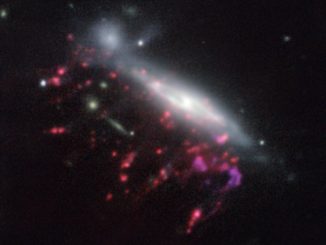
X-Headlines



Best ever image of another star’s surface and atmosphere
Using ESO’s Very Large Telescope Interferometer astronomers have constructed the most detailed image ever of a star — the red supergiant star Antares. They have also made the first map of the velocities of material in the atmosphere of a star other than the Sun, revealing unexpected turbulence in Antares’s huge extended atmosphere.

Supermassive black holes feed on cosmic jellyfish
Observations of “Jellyfish galaxies” with ESO’s Very Large Telescope have revealed a previously unknown way to fuel supermassive black holes. It seems the mechanism that produces the tentacles of gas and newborn stars that give these galaxies their nickname also makes it possible for the gas to reach the central regions of the galaxies, feeding the black hole that lurks in each of them and causing it to shine brilliantly.

Sneak peek of Gaia’s sky in colour
While surveying the positions of over a billion stars, ESA’s Gaia mission is also measuring their colour, a key diagnostic to study the physical properties of stars. A new image provides a preview of Gaia’s first full-colour all-sky map, which will be unleashed in its highest resolution with the next data release in 2018.


TRAPPIST-1 is older than our Solar System
Scientists now have a good estimate for the age of one of the most intriguing planetary systems discovered to date — TRAPPIST-1, a system of seven Earth-size worlds orbiting an ultra-cool dwarf star about 40 light-years away. Researchers say in a new study that the TRAPPIST-1 star is quite old: between 5.4 and 9.8 billion years. This is up to twice as old as our own Solar System, which formed some 4.5 billion years ago.



New Horizons’ next target might be a binary pair
Ground observations of the New Horizons spacecraft’s next target last month revealed the distant object, lurking in the outer Solar System more than four billion miles from Earth, might have an unconventional elongated shape, or even consist of two icy bodies orbiting one another in an age-old cosmic dance.
